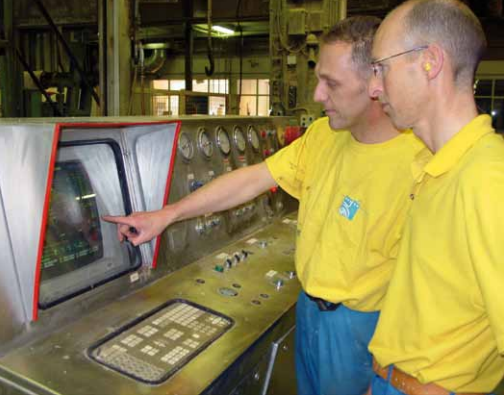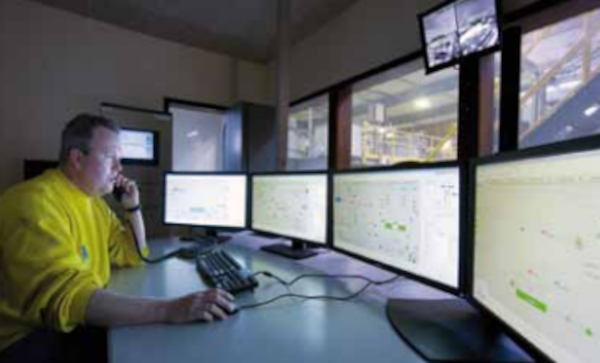More paper with less energy and waste
Van Houtum: More paper with less energy and waste
Interview from Fluids Processing, by Jaap van Ede
At paper manufacturer Van Houtum in Swalmen, multidisciplinary teams are improving production step by step. Energy savings and waste reduction are also a key focus. Most ideas in this area come from the operators themselves. To keep everything manageable, ever more production data is needed. HAI’s software is therefore used to set up a single production database containing all data from the process control systems, manually collected data, and quality inspections. Based on this information, further optimization is possible and relationships can be uncovered. After all, every production step—from pulp preparation to parent-roll production and the subsequent conversion into finished products—influences the others.

Van Houtum develops innovative and environmentally friendly solutions for toilet hygiene.
Its core business is producing toilet paper, paper towels, and wiper rolls, with or without matching dispensers. Once again, Bas Gehlen, Director of Operations, joins the discussion, accompanied by Hans van Houts, who—as training coordinator—is responsible for operator training. One of the guiding principles is flexible deployability, expressed as 1:3 and 3:1. This means each operator can work in at least three positions, and that in every shift at least three operators are available for each workstation.
Cradle to Cradle
Van Houtum’s products are high quality and made as environmentally friendly as possible. According to the company, they are the only manufacturer in the world to supply Cradle to Cradle–certified toilet and hand-towel paper, Satino Black. This means that only biodegradable and non-toxic additives are used in production. “Complaints about the quality of our products are rare. When improving our production processes, we therefore focus mainly on increasing production capacity while reducing energy demand and the amount of waste.” That’s not easy, because every step in the process affects the next: from waste paper to pulp, from pulp to parent roll, and from parent roll to finished products.
Insight. “If, for example, a paper roll becomes just a little thicker, it can be harder to process further down the line. Variation in raw materials—waste paper ranging from newspapers to office waste and labels—also plays an important role. To gain insight into all those relationships, we are currently implementing HAI’s software. That software consolidates production data from all our process-control systems, including manually measured items such as the weight and thickness of parent rolls. After that, you can visualize everything more clearly, trace problems, and look for cross-links.”
An example of an important quality parameter is the so-called wet strength. “Paper towels must not tear too quickly. That’s why additives such as polymers are used. But for cost and environmental reasons, you don’t want to add more than necessary. To gain full insight into everything that influences wet strength, you need all process data in a single database. With HAI we hope to achieve exactly that.”
Small Group Activities
Van Houtum’s products are high quality and made as environmentally friendly as possible. According to the company, they are the only manufacturer in the world to supply Cradle to Cradle–certified toilet and hand-towel paper, Satino Black. This means that only biodegradable and non-toxic additives are used in production. “Complaints about the quality of our products are rare. When improving our production processes, we therefore focus mainly on increasing production capacity while reducing energy demand and the amount of waste.” That’s not easy, because every step in the process affects the next: from waste paper to pulp, from pulp to parent roll, and from parent roll to finished products.
Insight. “If, for example, a paper roll becomes just a little thicker, it can be harder to process further down the line. Variation in raw materials—waste paper ranging from newspapers to office waste and labels—also plays an important role. To gain insight into all those relationships, we are currently implementing HAI’s software. That software consolidates production data from all our process-control systems, including manually measured items such as the weight and thickness of parent rolls. After that, you can visualize everything more clearly, trace problems, and look for cross-links.”
An example of an important quality parameter is the so-called wet strength. “Paper towels must not tear too quickly. That’s why additives such as polymers are used. But for cost and environmental reasons, you don’t want to add more than necessary. To gain full insight into everything that influences wet strength, you need all process data in a single database. With HAI we hope to achieve exactly that.”

Gaskap
A good example is optimizing the settings of the gas hood. The paper is dried by running it over a cylinder that is heated from the inside with steam. From above, warm, dry air is blown over the paper via a gas hood. “Although that air is recirculated, this last step consumes the most energy. An SGA team managed to lower the air temperature by 20–30°C. This now delivers annual energy cost savings of about €200,000.”
In the meantime, a new gas hood has been installed as well. This yielded a further 7 percent energy saving, while throughput is now 7 percent higher. This is mainly because the new gas hood encloses the paper more effectively. “The process runs so well primarily because the operators now know it inside and out and have it under control. You can buy a Ferrari, but if you don’t know how to drive it, it’s of little use.” The operator team continues to optimize the process further, partly on a trial-and-error basis—that is, by varying settings and then observing the effect.
This raises the question of whether things could be made more systematic by applying Design of Experiments (DOE) from Six Sigma, a method for reducing quality variation. In DOE, the influence of all environmental factors and process settings is investigated systematically with as few experiments as possible. “Applying DOE would indeed be a good idea, but for that you need the aforementioned database with all historical data. So we have to wait until HAI is up and running.”
Software As a Service
The gas hood operator team already has access to this system. The HAI plant information system was first connected to the Distributed Control System (DCS) that controls paper production. “This ABB DCS is designed to reliably control all control loops. The downside is that you can’t easily modify or add data-acquisition capabilities. That’s why we transfer the process data to HAI. This gives us more options for visualization and analysis.”
At a later stage, we also want to link HAI to DeltaV, the DCS that controls pulp production. In this way, we are gradually working toward the holy grail: a single production database for the entire process from waste paper to finished products.
ABB also supplies manufacturing execution solutions that can do roughly the same. “The idea to use HAI came from a consultant at Vapro. For us, that solution turned out to be the most practical and economical—also compared with extending SAP, our ERP system.” One advantage of HAI is that you can consume it as Software as a Service (SaaS). This means relatively low costs combined with a system that can be deployed and tested quickly.
What’s Next?
Due to the pilot’s success, HAI Logsheets have now been rolled out across all departments in the factory. The next step is to integrate data from in-process laboratory measuring instruments directly into HAI Logsheets. This will lead to further improvements, enhancing measurement quality and linking data from the wet and dry stages of the production process.
Get inspired
Get inspired by the success of others in the field of digital transformation, data-driven working and smart use of data (science) in the factory. Also consider applications in the areas of OEE, quality, release, golden batch, CIP cleaning, operator support, trending, Statistical Process Control, in-line measurements, production and technology dashboards, monitoring utilities and sustainability, and much more.
Don’t miss a thing and follow us on LinkedIn:


